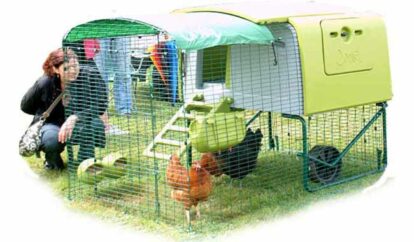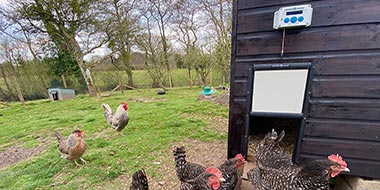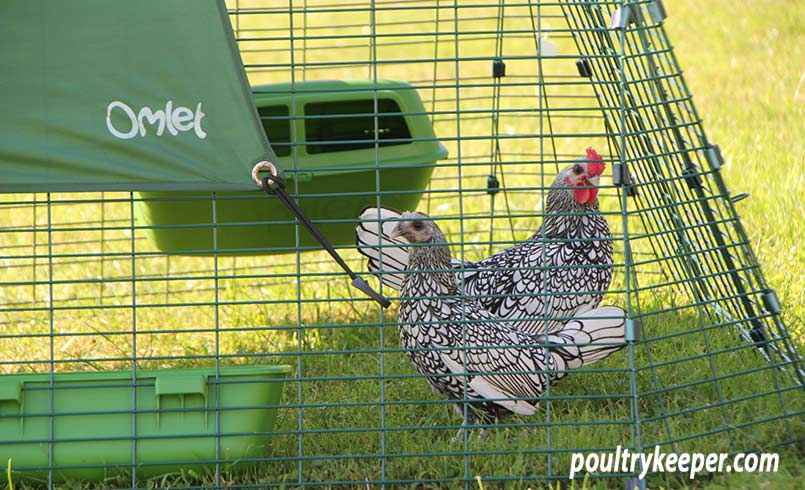
Equipment
Focus
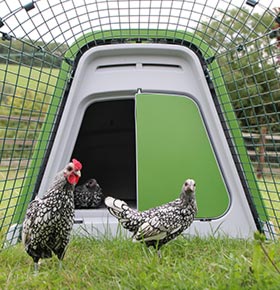
In this Equipment Focus, I have two versions of chicken coop lined up from Omlet. The Omlet Eglu Go chicken coop, and his taller brother, the Eglu Go Up. These are two small plastic coops, suitable for about three to four hybrid hens or up to half a dozen bantams.
In fact, I have three different plastic chicken coops and a walk-in run made by Omlet, and they are by far the most colourful and trendy chicken houses I have!
I started off writing a review of my Omlet Eglu Go chicken coop, but since the Eglu Go Up is the same coop raised up off the ground (with a different run configuration), I decided it would make sense to write one review for both of them.
The Eglu Go sits on the ground with a long run in front of it. There are no wheels [Edit March 2021: Omlet now have an option for wheels!]

The Eglu Go Up chicken coop sits on a frame just below waist height (a perfect height for young children to reach in to collect eggs!) and the run is shorter, but the chickens are able to use the space underneath their coop as well. There is a ladder for them to gain access to the coop and wheels for moving it to a new location.
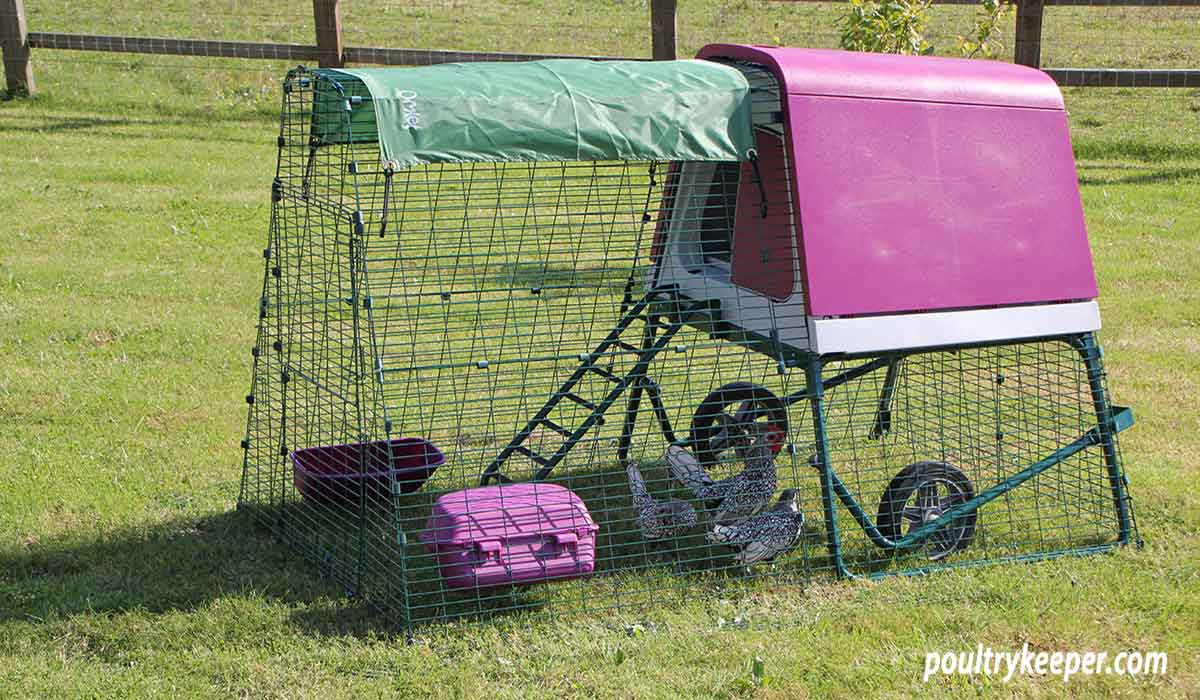
The Omlet story
The story of Omlet started in 2003 with the Eglu Classic, which was James Tuthill’s final year project on an Industrial Design Engineering course at the Royal College of Art. James created Omlet with three other friends, and they launched the Eglu Classic the following year.
Over the last thirteen years, the Eglu Classic has been one of the most iconic chicken houses of all time. It has been the chicken house of choice for a diverse list of celebrities, including John Cleese, Jamie Oliver, Emma Thompson and Katie Price, but where does the Eglu Go chicken coop fit in?
Naturally, as the company grew, so did their product range and today, the ‘Go is just one of the four plastic coops available from Omlet.
Omlet Eglu Go construction
The Eglu Classic and Cube designs use a manufacturing method called rotation moulding. Plastic is added to a mould, heated up until it melts and then spun around so that centrifugal force pushes the plastic into the mould’s shape. When cool, the mould is removed, leaving a hollow ‘chunk’ of plastic in the required shape.
Omlet used a different method for the Eglu Go. Parts are injection moulded and then clipped/screwed together to form the coop.
Injection moulded parts look different. They are flat (not hollow) and can be made more precise to fit together perfectly.
[Edit March 2021, the new style of Eglu Cube also looks like it uses injection moulded parts, I haven’t had an opportunity to see the new version yet.]

Access to the coop is via a rear door panel which comes away with a twist of the handle. I was concerned that the construction using injection moulded parts wouldn’t be as strong, it was, in fact, very robust, and once the coop was put together, I was impressed how the coop has been able to withstand the regular knocks from my lawnmower and being moved around the garden.

Access for the chickens is on the front of the Eglu Go. The door panel swings through 180 degrees by lifting and twisting the top handle. It locks in place, so there’s no worry about it flapping around in the wind.
Behind the chicken’s door, there are important ventilation slots with further ventilation on the rear access door. The coop is thick and well insulated to prevent condensation.
Cleaning an Eglu Go
I don’t think I have ever met anyone that enjoys cleaning a chicken coop. Well, me neither! In fact, it’s my least favourite chicken keeping job. I had never really given it much thought either; I just accepted that it had to be done and couldn’t be made any easier. A solid floor in a coop needs scraping, and the soiled bedding loaded into a bucket or wheelbarrow in our larger sheds.
When I used the ‘Go, I was pleased with how easy the weekly cleaning chore was.
The floor of the coop is made up of roosting bars that sit above droppings trays. The birds walk over these and perch on them to sleep at night. Droppings fall through onto the trays beneath so the birds aren’t walking on them.
To clean the ‘Go, it was really straightforward. Open the rear door, slide out the roosting bars and droppings tray, empty the droppings tray and bedding onto the compost heap and give both of them a wash down with the hosepipe. Leave to soak for a few minutes, then wipe them (I used a soft brush) another rinse, and they are good as new again!

Ease of cleaning was, in my opinion, the best thing about the housing from Omlet. They really have got this part of the design right, and it’s now making me curse my wooden housing when I have to scrape them out on my hands and knees!
The chicken run
The Omlet Eglu Go and Go Up have sturdy, integrated runs with an anti-dig skirt to stop foxes from burrowing underneath. Providing the run is on flat ground (it doesn’t need to be level, it can be on a slope), then it prevents foxes from digging underneath.
When the skirt is flat on the ground, it also allows you to pass the lawnmower over the top, providing the blade’s height setting isn’t too low which is a practical consideration.
Access to the run is through a door at the opposite end to the coop which has a long steel pin to secure it.

The run’s shape is aesthetically pleasing; the extra height at the access end makes it easier to reach in to change food and water.

The run panels are fastened together with some clever plastic clips. They won’t come apart unless pressure is applied in a certain direction, making them secure but reusable.
The Eglu Go chicken coop runs have a dark green painted finish that blends in well with the grass, and the mesh construction is sturdy enough to allow you to lift the Eglu Go and run together for repositioning.
Moving the Eglu Go & Eglu Go Up
The Omlet Eglu Go chicken coop and run need to be lifted by two people to move it onto fresh grass. Holding the coop is easiest if you remove the door, although that means removing your hens while lifting. Since the house sits directly on the ground, the grass will eventually die underneath it unless it’s moved regularly.
If you needed to get right inside the run, you would need to crawl in on your hands and knees, which concerned me at first, however after thinking about it, there weren’t really any situations when you would need to do this. To catch birds, they could be moved into the coop, and after the pop hole door was closed, you could open the access door at the rear of the coop.
The Eglu Go Up is far simpler to move. It has wheels that can be engaged on each side, lifting the whole run off the ground to move it.
You can also crouch down and go inside the run more easily. The ladder unhooks, so there is more space, should you need to catch some chickens.
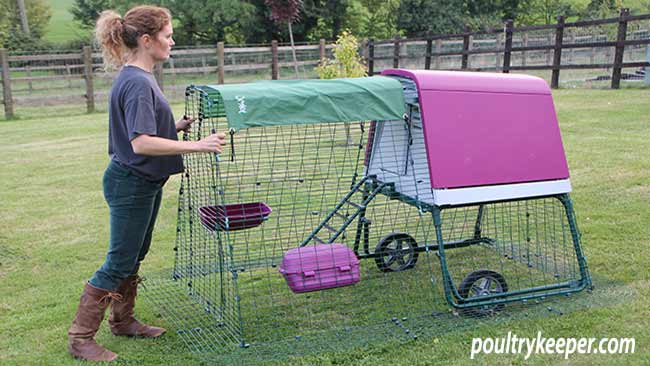
Conclusions
The Eglu Go and Go Up’s colourful designs look great in any garden, although admittedly, there will be people who love colourful plastic chicken coops and people who prefer natural wood.
The Eglu Go chicken coop must be placed on relatively flat ground, and access at the back is easy although at a low level, so those who find bending difficult should consider the Eglu Go Up.
In both coops, the tedious job of cleaning out is a breeze with removable roosting bars and droppings trays, a real revolution.
The run’s quality is excellent, although, with the reduced height, there may be occasions when you have to go on your hands and knees to get into the Eglu Go’s run.
My favourite out of these two coops is the Eglu Go Up chicken coop because it can be moved so easily on wheels with one person, and you can just about get into the run if you have to.
The Omlet web site is excellent, with lots of great photos and customer reviews, so I would suggest you visit the Eglu Go page if you would like further information.

